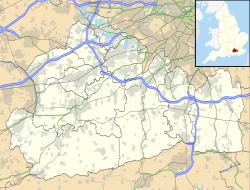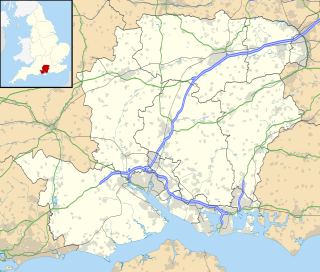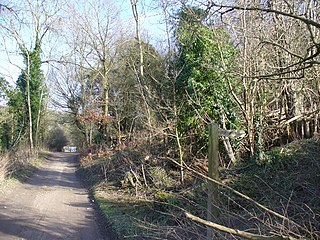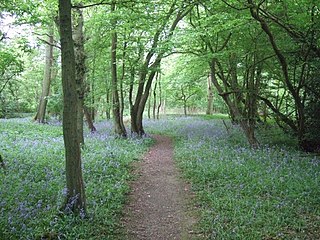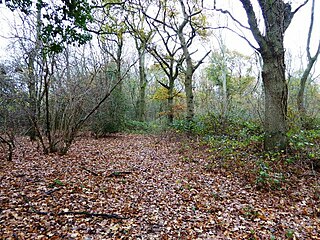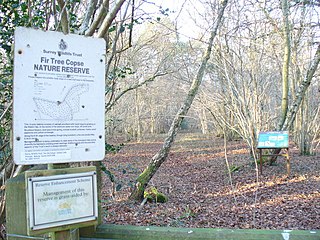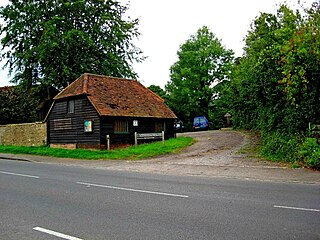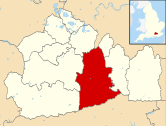| Oxmoor Copse | |
|---|---|
The copse is managed by the Woodland Trust | |
| Geography | |
| Location | Surrey,England |
| OS grid | TQ097467 |
| Coordinates | 51°12′34″N0°25′49″W / 51.2095°N 0.4304°W Coordinates: 51°12′34″N0°25′49″W / 51.2095°N 0.4304°W |
| Area | 1.23 hectares (3.0 acres) |
| Governing body | Woodland Trust |
Oxmoor Copse is just south of the village of Abinger Hammer and to the west of the village of Abinger Common, in Surrey. It is 1.23 hectares (3.0 acres) and is in an AONB lying within the Surrey Hills. [1] The previous owners gave the copse to the Woodland Trust as a gift.
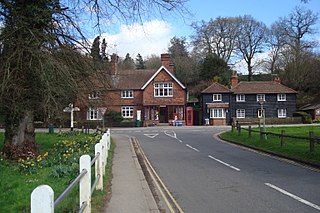
Abinger Hammer is a village or small community in a narrow part of the Vale of Holmesdale where it forms the valley of the River Tillingbourne and mainly on the parallel A25 in Surrey, England. Its homes, land and its parent civil parish are in the Surrey Hills AONB. It is approximately midway between the market towns of Dorking and Guildford — Guildford is the county town, just over 6 miles (10 km) west. The village is named after its mill which powered an iron forge.

Surrey is a subdivision of the English region of South East England in the United Kingdom. A historic and ceremonial county, Surrey is also one of the home counties. The county borders Kent to the east, East Sussex and West Sussex to the south, Hampshire to the west, Berkshire to the northwest, and Greater London to the northeast.

An Area of Outstanding Natural Beauty (AONB) is an area of countryside in England, Wales or Northern Ireland which has been designated for conservation due to its significant landscape value. Areas are designated in recognition of their national importance, by the relevant public body: Natural England, Natural Resources Wales, or the Northern Ireland Environment Agency. In place of AONB, Scotland uses the similar national scenic area (NSA) designation. Areas of Outstanding Natural Beauty enjoy levels of protection from development similar to those of UK national parks, but unlike with national parks the responsible bodies do not have their own planning powers. They also differ from national parks in their more limited opportunities for extensive outdoor recreation.
The copse lies on Greensand and the soil is acidic. The main trees are mature oaks and hazel; there are also bluebells. [2] A considerable number of trees were blown down in the 1987 storm. Replanting took place in 1991. Arable and pastoral land surrounds the copse. On the fringes of the copse there is a considerable amount of Common Cudweed but generally the copse is species poor. [3]

Greensand or green sand is a sand or sandstone which has a greenish color. This term is specifically applied to shallow marine sediment, that contains noticeable quantities of rounded greenish grains. These grains are called glauconies and consist of a mixture of mixed-layer clay minerals, such as smectite and glauconite mica. Greensand is also loosely applied to any glauconitic sediment.
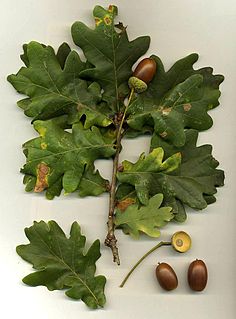
An oak is a tree or shrub in the genus Quercus of the beech family, Fagaceae. There are approximately 600 extant species of oaks. The common name "oak" also appears in the names of species in related genera, notably Lithocarpus, as well as in those of unrelated species such as Grevillea robusta and the Casuarinaceae (she-oaks). The genus Quercus is native to the Northern Hemisphere, and includes deciduous and evergreen species extending from cool temperate to tropical latitudes in the Americas, Asia, Europe, and North Africa. North America contains the largest number of oak species, with approximately 90 occurring in the United States, while Mexico has 160 species of which 109 are endemic. The second greatest center of oak diversity is China, which contains approximately 100 species.

The hazel (Corylus) is a genus of deciduous trees and large shrubs native to the temperate Northern Hemisphere. The genus is usually placed in the birch family Betulaceae, though some botanists split the hazels into a separate family Corylaceae. The fruit of the hazel is the hazelnut.
The grid reference is TQ 090 467

